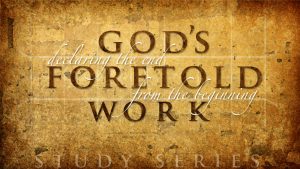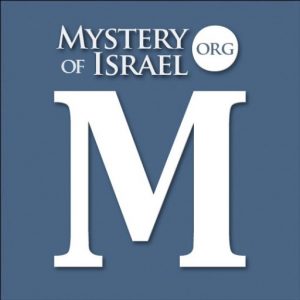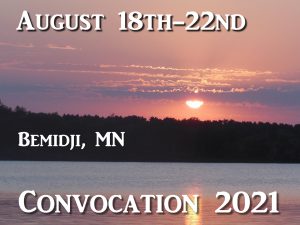Thu, May 1, 2008 I’ve never owned a Scofield Bible but a brother on the internet gave me the following below as an example of Scofield and dispensationalism teaching two peoples with two separate destinies. I dont quite know yet what to make of the statements. I just wanted to share them. I’m coming to see there is a diffference between classical pre-mill dispensationalism and the historical pre-mill view although I’m still doing some sorting in my mind. The brother said these were Scofield’s notes on Hosea 2:2. Just thought I would share it:
“That Israel is the wife of Jehovah (see vs. 16-23), now disowned but yet to be restored, is the clear teaching of the passages. This relationship is not to be confounded with that of the Church to Christ (John 3. 29, refs.). In the mystery of the Divine tri-unity both are true. The N.T. speaks of the Church as a virgin espoused to one husband (2 Cor. 11. 1,2); which could never be said of an adulterous wife, restored in grace. Israel is, then, to be the restored and forgiven wife of Jehovah, the Church the virgin wife of the Lamb (John 3.29; Rev. 19.6-8); Israel Jehovah’s earthly wife (Hos. 2.23); The Church the Lamb’s heavenly bride (Rev. 19.7).”
Hi, Doc. Thanks for this. I actually have a Scofield (the ’67 edition with word changes) and like it a lot. I favor its literal and futuristic approach to prophecy and Israel, but not its particular variety of dispensationalism, particularly its view of the nature of the church. There are two basic pillars that support ‘pre-tribulational’ dispensationalism. One is the doctrine of imminence (the view that no prophetic event stands in the way of the potentiality of an any moment coming of Christ, a potential that has existed since the earliest apostles first preached the ‘blessed hope’, which they define as exemption from the great tribulation). The second pillar is dispensationalism’s unique view of the nature of the church. According to dispensationalism, the church had no existence before Pentecost and does not (cannot) exist on earth after the rapture. I see both of these pillars as seriously flawed.
According to dispensationalism, there are two distinct programs of God, two distinct peoples of God, and two distinct dispensations for Israel and the church. The church belongs to God’s ‘mystery’ program for this dispensation only. The dispensation of the ‘church’ is seen as confined to the period between Pentecost and the rapture. In their view, the concept of the mystery removes the church from anything anticipated in OT prophecy. Therefore, it is believed that the dispensation of the church must end with the rapture before the “prophetic program” for Israel can be resumed. Thus the events of the last seven years (Daniel’s seventieth week), are understood to belong to an entirely different dispensation.
It is believed that the church is a mystery that occupies a parenthetical interim between Pentecost and the rapture, and thus stands in marked contrast to God’s “prophetic program” for Israel. According to dispensationalism’s erroneous view of the Pauline mystery, the church is so completely distinguished from even the righteous of Israel as to constitute a distinct people of God with its own distinct destiny. This doctrine of the two peoples of God is THE defining hallmark of pre-trib dispensationalism.
Note: (These features of dispensational thought developed in the mid 19th century out of an effort to understand the distinction between Israel and the church. Early, pretribulationism was not initially born out of a desire to escape tribulation as unfairly accused. Rather, the primary motive was to defend the hope that Christ could come any moment, i.e., the doctrine of imminence.)
We too distinguish between Israel and the church, but not in this way. There is another choice that does not require the dispensationalist’s notion of two peoples of God.
The election continues to go with the nation even in its unbelief. In that sense, the Jewish people remain beloved (foreloved) as a people, and can be rightly called ‘the chosen people’. But are they another ‘people of God’? True, the Jewish people remain a necessarily distinct people of covenant destiny. To this end the Jews are miraculously preserved in order to publicly demonstrate and openly vindicate the power and election of God towards this people. (“What shall the receiving again them be but life from the dead?”) But the promise of coming salvation, and the preservation of a national identity to that end, assumes nothing concerning personal salvation of individual Jews. So the question of whether there is more than one people of God is more nuanced than recognized by the simplistic ‘either / or’ choice pressed by one school against the other.
In contrast to both replacement theology and dispensationalism, we believe that the distinction between Israel and the church is better compared to the distinction that always existed between the elect nation and the more specific election of grace from within the nation, namely, the righteous remnant.
Through the revelation of the mystery of the gospel, that righteous remnant, now become the eschatological remnant of first-fruits, can be defined as the ‘body of Christ’ comprised of all who are indwelt by the ‘Spirit of Christ’. In my view, the body of Christ (though it could not have been known by that term) includes the OT righteous (see 1Pet 1:11, “the Spirit of Chirst which was ‘in’ them”).
With the new revelation has come a new language. But this is where we need to exercise caution. We learn from the doctrine of Christ’s pre-existence that for something to be newly revealed does not mean that it has come newly into existence.; This is an important distinction when we are speaking of Christ and the church. Much has come to light in the gospel that had real existence before the dispensation of the fuller revelation. This applies as much to the ‘body of Christ’ as to Christ Himself and the unity of persons in the Godhead.
We believe that the church now revealed and described as the body of Christ is in indivisible continuity with the ‘remnant according to the election of grace’ that existed throughout Israel’s history and before. Israel as a nation remains elect despite its temporary unbelief. It’s destiny is only discernible by covenant and prophecy, not by its temporal behavior. The nation’s long history of apostasy cannot thwart the appointed time of transformation (Ps 102:13). This is necessary because of the demands of the covenant that remain unfulfilled apart from the reinstatement of the ‘natural branches’.
Never could the presence of a mere remnant guarantee the nation’s continuance in holiness in the Land as specified in promise and prophecy (literally understood). This can only be accomplished by the salvation of ‘all Israel’, which means the end of the remnant, since from that time ‘all’ know Him forever (Jer 31:34; 32:40; Ezek 34-39). This is everywhere shown to come no sooner than the apocalyptic day of the Lord (Isa 59:21; 66:8; Ezek 39:22; Zech 3:9). Only the coming of the revealing regenerating Spirit upon the surviving remnant as a whole can guarantee the kind of enduring national obedience necessary to continue in the Land ‘forever’, thus establishing the ‘everlasting’ covenant by an ‘everlasting’ righteousness (Dan 9:24; Jer 32:40; Isa 60:21).
Hence, Pentecost represents a first-fruits of that coming eschatologial transformation of the nation. This is the revelation that has made the church the church, and when Israel will receive the same revelation ‘in that day’, it too will be no less church, and no less the body of Christ, albeit in a unique stewardship of divine commission on the earth, as the long promised light that will lighten multitudes of gentiles throughout the millennium of Israel’s glory (Isa 60:5). It is to this church of the eschatological remnant of first-fruits that the gentiles have been added in unexpected numbers. As an eschatological entity, the church, like Paul (Act 13:47), understands its apostolic task as a first-fruits anticipation of Israel’s commission to lighten the nations. None of this supplants or replaces the covenant promise that envisions the salvation of the nation, but rather constitutes a first-fruits anticipation of that very eschatological glory, which is the “without which not” of covenant fulfillment (of any literal kind). Your prayers are so deeply appreciated.
In His great goodness, Reggie
Followup Question:
On Mon, May 5, 2008:
Hi Reggie, have you ever seen or read the book, “The Great cover up” A research project (I guess) that traces the origination of pre trib back via, Dallas theological college, Schofields the brethren and Darby to the McDonald family in Scotland. Apparently their daughter Mary I think was very prone to long (and way out) prophetic utterances (some of which were documented ) I believe Darby or Irving actually attended these meetings and took the idea back to the Brethren. The book contains some documentation and actual eye witness accounts.
I believe after promoting this view a number left the brethren over this including George Muller the father of orphans who said something like, I can have my bible or can have Darby and so I choose to leave and keep my bible.It was a long time ago I read this so my memory may fail me but that was the gist
Christian love and kind regards
Hi Robert. Yes, I’ve read McPherson a long time ago in a first edition of his book. There was quite a gathering of gifted ministers in the original brethren movement. Some from both sides of the rapture question are noted for their substantial work as writers and theologians. My favorites are Tregelles and Newton; both parted ways with Darby over his innovation.
It is most interesting that just when so many gains were being made in the restoration of prophetic truth, the pre-trib rapture theory was brought in like the proverbial Trojan Horse into the evangelical camp. It became the dominant view.
Actually Margaret McDonald’s prophecies presupposed a split rapture distinguishing the spiritually fit (the five wise) from other less perfected believers who would get straightened out by passing through the tribulation. So it wasn’t the pretrib rapture of the classic dispensationalism variety as formulated by Darby and popularized in the Scofield Bible. This remains the view of those that identify themselves as ‘classic dispensationalist’. Margaret McDonald’s view was more in keeping with the partial rapture that some Pentecostals continue to teach.
I seem to recall that Darby’s more refined synthesis occurred to him during a season of illness somewhere in the mid 1830’s. The supposed revelation confirmed for him the the supposed separation of the church and Israel and their different destinies on the basis of 2Thes 2:7. He was the first to deduce that if the restrainer was the Holy Spirit, then His removal assumed the removal of the church, as those indwelt by the Spirit. The idea suggests a ‘reversal of Pentecost’ (John Walvoord) whereby the Holy Spirit will no longer indwell the so-called ‘tribulation saints’.
After the rapture, the Holy Spirit returns to His former relationship of merely ‘with’ or ‘upon’, but not ‘in’ the faithful, as believed to be the case with the saints of the OT. Thus, the pre-trib rapture of the church as concurrent with the removal of the Holy Spirit as the ‘one who now holds back’ the Antichrist, the ‘blessed hope’ is protected as an imminent event, since in this way the church of this ‘mystery dispensation’ is kept separate from the sign events of God’s prophetic program with Israel. Thus the two peoples of God. The church is the heavenly people with heavenly promises (covenants?) and heavenly destiny, while Israel is the earthly people of God, with earthly promises and an earthly destiny.
So the Lord’s manifest return after the tribulation (Mt 24:29-31) is not for the church. Rather, the purpose of Christ’s post-tribulational coming is to end the times of the Gentiles and to establish His mediatorial kingdom over the millennial earth and rule out of a restored Israel. So the rapture is distinguished from the so-called ‘kingdom coming’.
Grace and peace, Reggie




